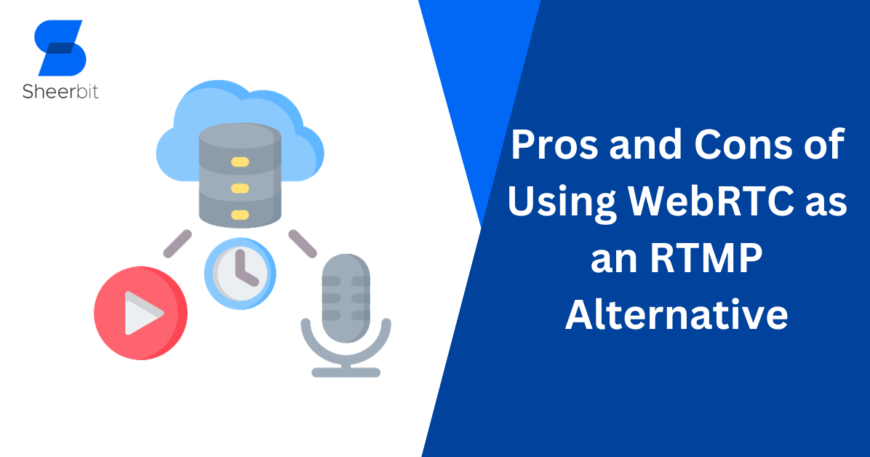Sophisticated and dependable solutions are becoming increasingly important in the ever-evolving world of online multimedia streaming. For a considerable amount of time, Real-Time Messaging Protocol (RTMP) was the recommended protocol for online music and movie streaming. Nevertheless, WebRTC, or Web Real-Time Communication, is gaining traction as a strong replacement. In this post, we will look at the pros and cons of WebRTC as an alternative to RTMP to help you decide whether to switch.
Pros of Using WebRTC as an RTMP Alternative
-
Low Latency:
One of the critical advantages of WebRTC over RTMP is its incredibly low latency. WebRTC is ideal for online gaming, video conferencing, and real-time broadcasting, as it was designed for real-time communication. Few milliseconds of delay are possible, ensuring nearly instantaneous data exchange.
-
No Plugins or Downloads:
Unlike RTMP, which usually requires the installation of plugins or other software to decode and play the content, most modern web browsers support WebRTC by default. Because end users may access your material without needing to install additional software, making the experience seamless and user-friendly.
-
Secure Communication:
As WebRTC employs robust encryption methods, your data and media files are secure throughout transmission. This security is crucial, especially for live streaming and video conferences with sensitive information.
-
Adaptive Bitrate Streaming (ABR):
Because WebRTC allows adaptive bitrate streaming, the stream’s quality can be changed by the server based on the viewer’s internet connection. This creates a smoother streaming experience and ensures the film is accessible to a larger audience regardless of their internet connections.
-
Browser Compatibility:
Since WebRTC is compatible with a wide range of web browsers, including Microsoft Edge, Mozilla Firefox, and Google Chrome, it may be used by a sizable user population. This compatibility facilitates the process of disseminating your content to a broad audience.
-
Cross-Platform Compatibility:
Any operating system does not limit WebRTC. Whether your audience is on Windows, macOS, Linux, or mobile devices, WebRTC ensures they can view your content without issues.
Cons of Using WebRTC as an RTMP Alternative
-
Firewall and NAT Traversal Challenges:
WebRTC is known for having low latency, although it can sometimes have issues communicating with firewalls and Network Address Translation (NAT). These bugs may cause connectivity issues for some users, which can be a significant drawback.
-
Scalability:
RTMP has been widely used for live events and broadcasting on a considerable scale. Although WebRTC has many applications, the extra work involved in keeping up real-time connections with many viewers may restrict its usefulness for large audiences.
-
Lack of Advanced Features:
Sophisticated features like server-side recording and server-based transcoding are necessary for particular use cases, and RTMP can handle them. WebRTC does not come with these features out of the box, and further development effort could be required to provide equivalent functionality.
-
Resource Intensive:
WebRTC may use many resources on both the client and server sides. This suggests that you need more reliable equipment and infrastructure, which could increase costs to ensure uninterrupted streaming.
-
Mobile Data Consumption:
Customers with restricted mobile data plans may be concerned about higher data consumption because WebRTC is real-time and has minimal latency. Price increases for consumers who stream media on their mobile devices might result.
-
Complex Implementation:
It may be more challenging to install WebRTC than RTMP, particularly for those who need to become more familiar with real-time communication protocols. It could require more labour in the development process and a steeper learning curve.
When to Consider Using WebRTC as an RTMP Alternative
After reviewing the advantages and disadvantages of WebRTC as an alternative to RTMP, it’s essential to consider the scenarios in which WebRTC can be the most suitable choice for your streaming needs. In the above methods, WebRTC could be a suitable alternative:
-
Low-Latency Applications:
If your streaming application—such as online gaming, real-time chat, or interactive live broadcasting—needs very low latency, WebRTC is a beautiful choice.
-
Security is Paramount:
Because of its built-in security features, WebRTC is a competitive choice for applications that handle sensitive data, such as telemedicine services.
-
Plugin-Free Experience:
If you want to provide your audience with a seamless streaming experience without requiring additional installations, WebRTC is the way to go.
-
Adaptive Bitrate Streaming:
Even though addressing audiences with varied internet connections is a significant priority, all viewers may enjoy a more flawless experience thanks to WebRTC’s adaptive bitrate streaming functionality.
-
Cross-Platform Reach:
Because of WebRTC’s broad compatibility, your content will be seen by everybody, even if your audience is heterogeneous and uses a variety of browsers and devices.
Conclusion
The ongoing discourse surrounding WebRTC as an alternative to RTMP clarifies that it offers several advantages, such as decreased latency, security, and cross-platform compatibility. However, it also carries challenges, including firewall and NAT traversal issues, limitations on scalability, and increased resource needs. Your choice to switch to WebRTC should ultimately be based on your streaming requirements.
Make sure WebRTC meets your goals and the needs of your target audience by carefully weighing its advantages and disadvantages before replacing RTMP. In many cases, WebRTC may offer a superior streaming experience, but knowing its limitations and potential issues is essential.
Are you ready to learn more about WebRTC’s benefits over RTMP for your streaming needs? To find out how WebRTC may enhance your online multimedia experience, contact our experts right now. Acknowledge real-time communication as the way of the future and benefit from its numerous advantages.





